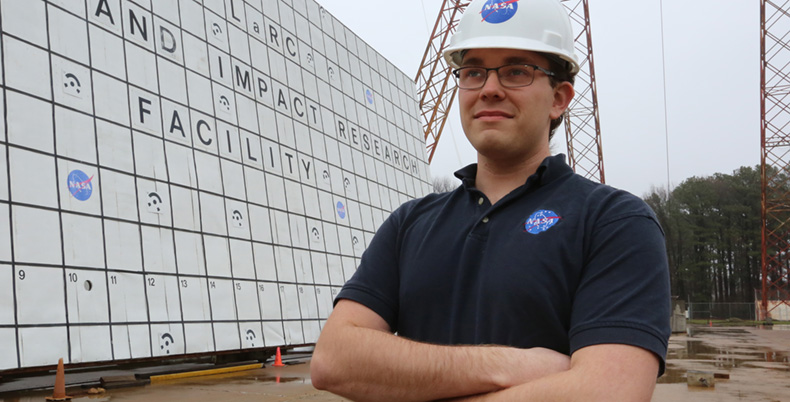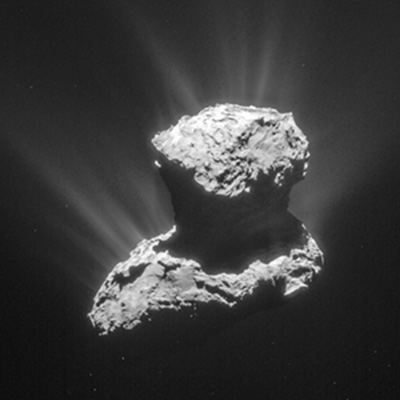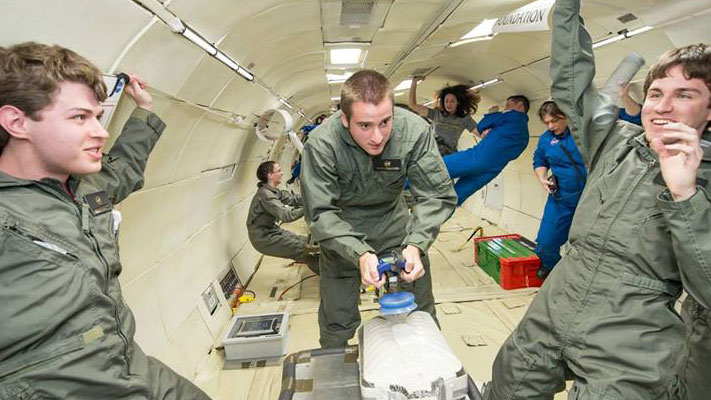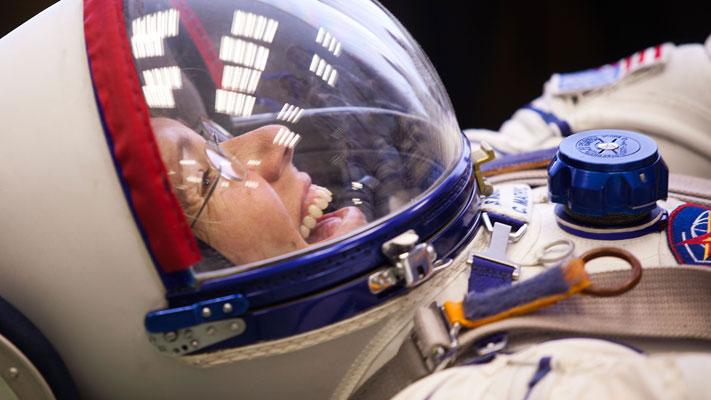
Doctoral student Paul Friz worked with NASA last fall in California and is working with the space agency again this year in Langley, Virginia. Here he’s at the Langley gantry, where crash tests are conducted on spacecraft, aircraft and helicopters. Contributed photo by David C. Bowman, NASA
When he was a teenager, Missouri S&T doctoral student and NASA employee Paul Friz looked up into the night sky, the twinkling points of light a thousand beacons in the darkness, irresistible. He was hooked.
So when he was 14, Friz saved up his lawn-mowing money and bought his first telescope – an 8-inch Dobsonian Reflector – to bring the sky’s lights up close. He looked at the gas giant Saturn; it’s the solar system’s sixth planet from the sun and looks like a star to the naked eye, but its rings and moons came to life in his telescope’s lens. Then he went farther into the heavens and out of Earth’s solar system – somewhere between 520 to 610 light years out – to view M44, or the Beehive Cluster, located in the constellation Cancer.
“I believe I chose those objects because they were easy to find in the sky, and I didn’t really know what I was doing at that point,” Friz says.
Looking through that first telescope in a cemetery behind his Creve Coeur, Missouri, home was the first step in a journey that has led Friz, 25, to where he is today: working as a NASA Pathways intern in Langley, Virginia, and pursuing his Ph.D. in aerospace engineering from S&T.
At NASA, he’s learning software tools that will help him complete cost analyses for space missions, taking into account a mission’s lifetime, research and development, maintenance, operating costs, scientists’ hours – basically everything that has a dollar amount.
Before that, Friz was at NASA’s Jet Propulsion Laboratory in Pasadena, California, as an assistant to the project manager on the Rosetta mission that put an orbiter around comet 67P/Churyumov-Gerasimenko. His specific job involved writing software to analyze the data coming from the Microwave Instrument for Rosetta Orbiter, or MIRO, that’s on the Rosetta spacecraft. MRIO measures the comet’s gas emissions, which, Friz says, are mostly water with smaller amounts of ammonia, carbon dioxide and methanol.
He was there when the orbiter launched the Philae lander that synched up with and landed on the comet. When it finally touched down and started sending data, the relief in the room was palpable.
“It was awesome,” Friz says. “It definitely was one of the most exciting experiences in my life.”

Paul Friz worked on the joint European Space Agency and NASA project that deployed the Rosetta orbiter around Comet 67P/Churyumov-Gerasimenko. This image of the comet was taken March 25, 2015, from a distance of 86.6 km from the comet’s center. Contributed photo by ESA-European Space Agency. Used with permission under license: http://creativecommons.org/licenses/by-sa/3.0/igo/
The path that led him to being there in the room with the other NASA scientists just sort of came about naturally.
“There was no real eureka moment,” he says of his early stargazing days, which included trips to an aunt and uncle’s house in a remote area east of Rolla. “Mostly I was just really interested in exploring and learning awesome things about the universe.”
After earning his bachelor of science degree in physics from Truman State University in Kirksville, Missouri, he came to S&T and earned a master of science degree in aerospace engineering. He worked on two different projects during his master’s studies, and both are part of his thesis.
Because his interests are wide and varied – he was an orchestral violinist at Truman State and is an accomplished photographer – he hasn’t settled on a Ph.D. area of concentration. He’s plenty busy as it is with the work he’s doing for NASA – his dream long-term employer. Projects such as sending astronauts to Mars and an asteroid redirect project that aims to capture an asteroid and put it in orbit around the moon hold his imagination.
“They’re bigger than anything NASA has done; bigger than the Apollo landing,” Friz says.
He acknowledges, however, that these big-dream projects have no guarantee of being funded.
“It seems that Mars has been 20 years away ever since we landed on the moon,” he says.
Still, he’s undeterred. The stars of his youth are the stars of his future.
“Going to space has always been a dream of mine,” he says. ”If I ever have the opportunity to be an astronaut I will take it, but there are thousands of other people who are more qualified for that job than I am. So right now, I’m not betting on it. But I am aligning my career and lifestyle so that I can take the opportunity if it comes up.”
By Joe McCune


Recent Comments